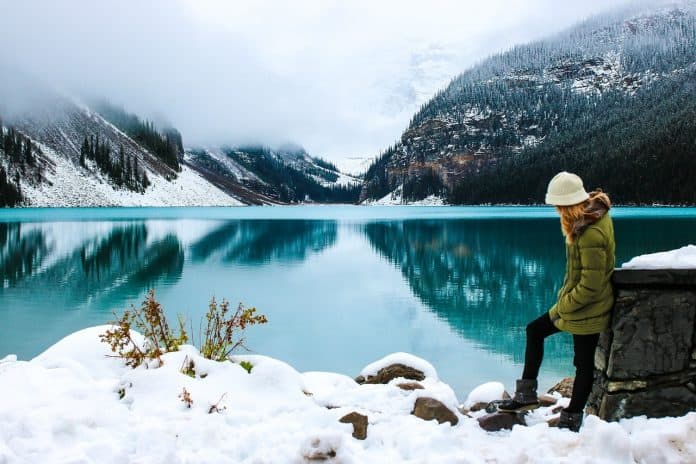
When it comes to venturing into the great outdoors, preparation is your pathway to an enriching adventure. Ensuring you have a comprehensive camping gear checklist is pivotal to experiencing the wilderness safely and comfortably. Whether you’re a seasoned explorer or new to the world of outdoor excursions, possessing the right outdoor adventure equipment can make a world of difference. In this guide, we delve into the nuances of compiling essential campsite tools tailored for a variety of natural landscapes and adventure durations. So, as we embark on this journey together, let’s gear up for an unforgettable escapade beneath the open skies.
Beyond the excitement and anticipation that comes with planning your next retreat into nature, we understand the significance of being well-equipped. From the tranquility of a lakeside to the challenging trails of a mountainous terrain, your gear is more than just items in your backpack—it’s your partner in creating lasting memories and ensuring your return home with stories to tell. Let’s traverse the realms of outdoor preparedness, ensuring every camper is ready to face the elements with confidence and ease.
Key Takeaways
- Understand why a thorough camping gear checklist is crucial for outdoor adventures.
- Discover the essential campsite tools needed for various camping scenarios.
- Learn the importance of proper outdoor adventure equipment for different environments.
- Gather tips for prioritizing gear that enhances safety and enjoyment during your camping trip.
- Get insights on how to personalize your camping gear checklist to fit your unique outdoor journey.
Starting with the Basics: Essential Camping Gear List
For any outdoor enthusiast, a well-thought-out camping checklist is the cornerstone of a successful foray into the wilderness. It is critical to invest in reliable hiking boots like the ones you can find at sites like dwights.co.nz, prepare with portable camping stoves for mealtime, and never underestimate the importance of wilderness navigation tools. Let’s explore the essential gear that should be on every camper’s list to ensure a safe and enjoyable experience in the great outdoors.
Shelter and Comfort: Tents, Tarps, and Sleep Systems
Choosing the right accommodations for your camping adventure shouldn’t be taken lightly. A well-selected tent provides the first defense against the elements, while tarps can offer additional protection or serve as makeshift outdoor shelters. Together, these elements create a haven of comfort, away from home.
- Consider the tent size and its capacity to withstand various weather conditions.
- Look for tarps that are durable, lightweight, and easy to set up.
- Pair your shelter with an appropriate sleeping bag and an insulating pad for optimal rest.
Cooking in the Wild: Stoves, Utensils, and Food Storage
Cooking amidst nature can be one of the most enjoyable aspects of camping, but only if you’ve packed the right gear. Portable camping stoves are a must-have for preparing hot meals, and a set of sturdy utensils will make dining outdoors a breeze.
| Equipment | Usage | Benefits |
|---|---|---|
| Portable Camping Stove | Cooking | Efficiency and control |
| Utensil Set | Eating | Durability and convenience |
| Bear-Proof Food Canister | Food Storage | Safety and compliance with park regulations |
Navigation Tools: Maps, Compasses, and GPS Devices
When venturing into the wilderness, a solid understanding of navigation is imperative. Arm yourself with a detailed topographic map, a reliable compass, and a GPS device, ensuring you keep your bearings and make informed decisions about your route.
- Learn to read and interpret maps for comprehensive wilderness navigation.
- Practice using a compass in conjunction with your map to orient yourself.
- Carry a GPS device as a backup and for pinpoint precise locations.
With these fundamentals in place, your foundational camping gear will enhance your trip’s safety, efficiency, and overall enjoyment.
Choosing the Right Hiking Boots
When preparing for a hike, the significance of selecting the best hiking boots cannot be overstated. The right boot can ensure an enjoyable journey across any terrain, while a poor choice may lead to discomfort or even injury. Let’s examine what features you should prioritize to secure the optimum blend of comfort and durability in your trekking footwear.
Footwear for Different Terrains: What to Look For
Deciphering the kind of trail shoes suitable for your hiking adventure is crucial. Here are some considerations:
- Grip: Look for outsoles with deep lugs that provide traction on both wet and dry surfaces.
- Ankle Support: High-cut boots are ideal for uneven terrains, reducing the risk of sprains.
- Waterproofing: Boots with a waterproof membrane keep your feet dry, which is essential for comfort and warmth.
- Durability: Tough materials can withstand harsh conditions, ensuring your boots last for more hikes to come.
Understanding these elements assists in navigating the multitude of options available and directs you towards the best hiking boots for your specific needs.
Ensuring Comfort: The Importance of The Right Fit
Finding a perfect boot fitting is an art. Inadequate fitting can lead to discomfort, so consider the following tips:
- Measure your feet late in the day when they are at their largest to ensure a true fit.
- Wear the socks you’ll hike in when trying on boots to account for the extra cushioning they provide.
- Ensure there’s a thumb’s width of space in front of the big toe to avoid impact when walking downhill.
- Walk on an incline to test how the boot holds the heel in place; it shouldn’t slip or rub.
Comfort in boots not only elevates the hiking experience but also wards off potential injuries. It’s worth visiting a specialized outdoor retailer where you can receive expert advice and boot fitting.
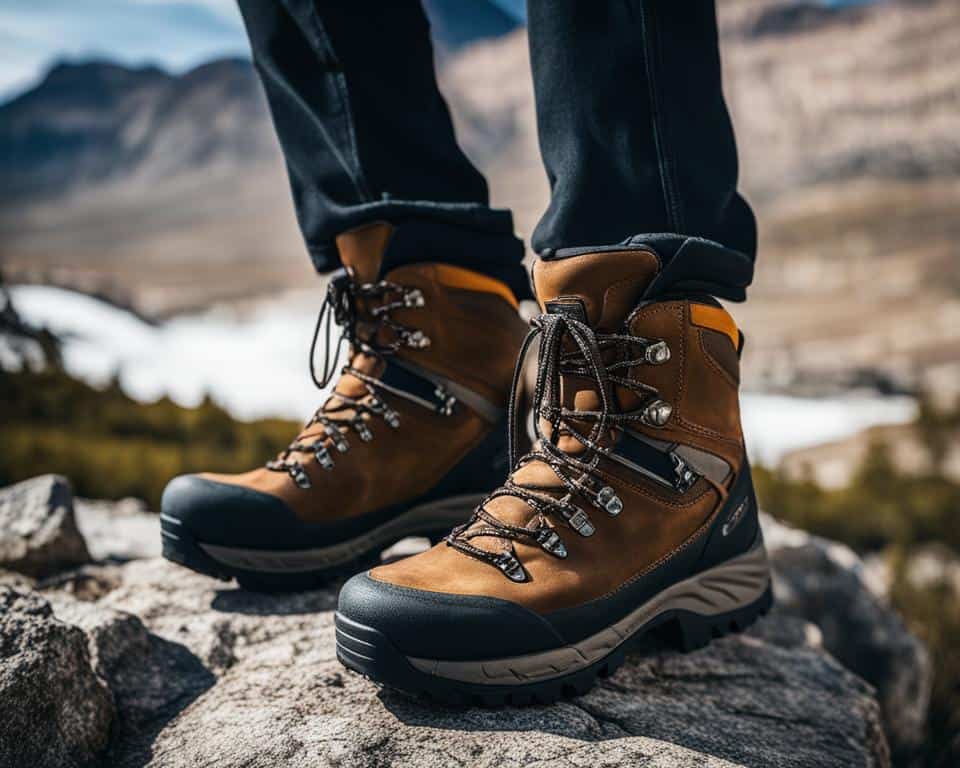
Whether you are scaling a rugged mountain or taking a leisurely trail walk, the correct pair of trekking footwear can make a world of difference. Stay true to these guidelines and your feet will thank you for every step of your journey.
Weather-Proofing Your Adventure: Clothing and Gear
When venturing into the great outdoors, encountering a variety of weather conditions is inevitable. To ensure your experience is not just survivable but enjoyable, it is critical to invest in weather-resistant camping gear and outdoor clothing designed to handle the unpredictability of nature. Adapting your apparel through effective layering for outdoors can create a versatile system that can be modified on-the-go as temperatures and conditions shift.
The foundation of weather-proofing begins with base layers that manage moisture and retain heat even when wet. Merino wool and synthetic fabrics excel in this role, offering breathability and quick-drying capabilities. The middle layer serves as insulation, and popular materials include fleece or down, which trap warmth efficiently. The outer layer, or shell, should be not only waterproof but also breathable to shield against rain and wind while preventing overheating.
For equipment and electronic devices, weather-proof gear is a must. Dry bags and protective cases that are both waterproof and dustproof secure the safety of your essentials from smartphones to cameras. With the right gear, you’ll extend not only the lifespan of your devices but also your comfort and joy in the wild.
Remember, the unpredictability of nature doesn’t mean your comfort has to be unpredictable. Invest in quality layers and gear to protect against the elements, and turn your attention to the beauty around you.
| Layer | Function | Materials | Recommended Brands |
|---|---|---|---|
| Base | Moisture Management | Merino Wool, Synthetics | Patagonia, Smartwool |
| Mid | Insulation | Fleece, Down | The North Face, Arc’teryx |
| Outer | Protection | Gore-Tex, eVent | Marmot, Columbia |
| Gear Protection | Waterproofing | Sealed Seams, Dry Bags | Sea to Summit, Pelican |
As you curate your collection of outdoor wear and accessories, such as walking sticks, keep in mind that each piece is not just a singular item but a part of a comprehensive defense against the forces of nature. Choosing garments and gear with foresight allows you to seamlessly transition from a sunny trail to a windy ridge without skipping a beat.
Stay Hydrated: Water Purification and Storage Options
When camping, staying properly hydrated is a non-negotiable element of your health and safety. With the absence of readily available potable water, water purification methods become essential. Additionally, finding ideal hydration systems and camping water containers can be critical for your convenience and comfort during the adventure.
There are multiple water purification techniques to consider, each with its own set of benefits. For simplicity and effectiveness, many campers turn to portable filtration systems. They range from pump filters to gravity-fed options. On the chemical front, iodine or chlorine purifying tablets are compact and relatively easy to use. For tech-savvy trekkers, UV light purifiers offer a quick and chemical-free method to cleanse water of pathogens.
- Filtration systems: Fine for removing bacteria and protozoa.
- Chemical treatments: Effective against viruses, lightweight, and budget-friendly.
- UV light purifiers: Fast and effective but require batteries or charging.
Choosing the right camping water containers is also essential. Options vary from foldable bottles to rigid jugs, with hydration packs providing a hands-free experience. To guide your selection, consider:
- Durability for your adventure’s demands.
- Capacity, depending on trip length and water availability.
- Portability, with weight being a key factor for backpacking.
See the comparison below to assist you in selecting the appropriate purification method and storage solution for your next trip.
| Purification Method | Pros | Cons | Best For |
|---|---|---|---|
| Filtration Systems | Portable, Removes larger pathogens | Can be bulky, Requires manual effort | Areas with clear but contaminated water |
| Chemical Tablets | Lightweight, Long shelf-life | Taste alteration, Requires wait time | Emergency use and backup |
| UV Light Purifiers | Quick, No chemicals | Dependent on battery life, Less effective in murky water | Short trips and clear water sources |
Finally, remember that no single method is perfect for every scenario. It’s prudent to carry a backup, such as tablets, even if you rely primarily on a filter or UV purifier. This ensures hydration is never compromised. With these tools and knowledge, you’re all set for safe and enjoyable hydration on your outdoor explorations.
Be Prepared: First Aid and Safety Essentials
A well-prepared camper is a safe camper, and when it comes to venturing into the great outdoors, your camping first aid kit and outdoor safety tools should be as crucial as your tent or sleeping bag. Understanding the fundamentals of emergency survival techniques can make all the difference in a precarious situation. Let’s delve into what makes a comprehensive first aid and emergency kit.
Building Your First Aid Kit: Must-Have Items
Whether you’re dealing with minor scrapes or more significant injuries, your first aid kit is the first line of defense. It’s imperative to tailor your kit to the nature of your trip, the environment, and the size of your group. Below is a list of essential items that should form the core of any camping first aid kit.
- Adhesive bandages of various sizes
- Sterile gauze pads and adhesive tape
- Antiseptic wipes and creams
- Tweezers and scissors
- Pain relief medication, such as ibuprofen or acetaminophen
- Antihistamines for allergic reactions
- Emergency blanket to retain body heat
- Disposable gloves for hygiene
Remember, this list is not exhaustive. Depending on the trip’s specifics, additional items like a snake bite kit or altitude sickness medication may be necessary.
Emergency Preparedness: Tools and Techniques
Aside from medical supplies, certain tools can prove invaluable in an emergency. Coupling these with knowledge of basic survival techniques enhances your readiness for any unforeseen situation.
- A multi-functional tool with a knife, pliers, and other essentials
- Water purification tablets or filtration system
- Fire-starting gear such as waterproof matches or a windproof lighter
- Emergency whistle for signaling
- Don’t underestimate the importance of navigational tools like a compass and map, even if you have a GPS device.
Knowing how to use these tools, like applying a tourniquet or creating a signal fire, could be life-saving. Participate in a wilderness first aid course to complement your gear with knowledge.
| Item | Use | Notes |
|---|---|---|
| Thermal blanket | Temperature regulation | Also useful for signaling due to reflective material |
| Signaling mirror | Visual signaling over long distances | Compact and requires no power source |
| Paracord | Multipurpose use for repair, building shelter, etc. | A must-have for its strength and versatility |
Thorough preparation is key to a memorable and safe camping experience. With the right camping first aid kit and a solid grasp of emergency survival techniques, you’re well on your way to enjoying all that nature has to offer with peace of mind.
Light Up the Night: Illumination Tools for Camping
When the sun dips below the horizon, the allure of the night sky invites campers to continue their outdoor activities. However, a key aspect of nighttime safety and convenience in the wild is proper camping lighting. From headlamps that offer hands-free operation to bright lanterns that bathe the campsite in light, it’s crucial to have reliable light sources. Even the most rugged flashlights can be lifesavers on a dark trail. Understanding the attributes of each lighting option will ensure that you choose the best tools for your camping needs.
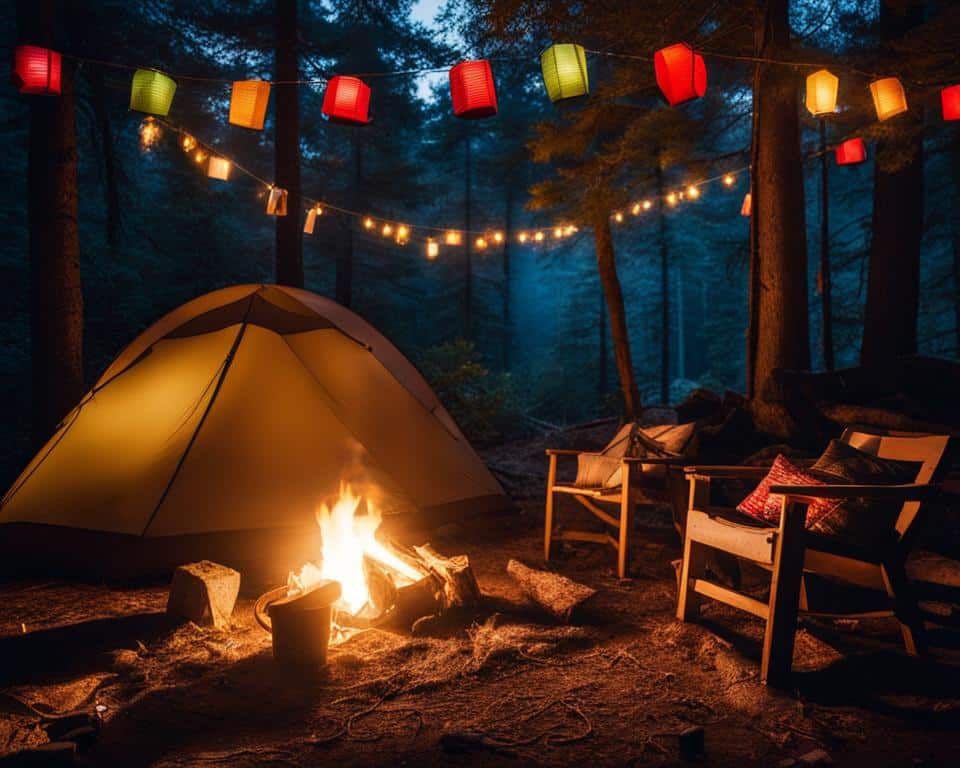
Among the variety of lighting gear available, here’s what to consider:
- Battery Life: The duration your light will operate on a single charge or set of batteries.
- Brightness: Measured in lumens, this will determine how well you’ll see or be seen.
- Durability: A light’s ability to withstand drops, water, and the general wear and tear of outdoor use.
Below, a comparison of popular lighting tools has been compiled to assist in selecting the most appropriate for different scenarios:
| Lighting Tool | Best For | Pros | Cons |
|---|---|---|---|
| Headlamps | All-around use, hands-free operation | Lightweight, targeted light direction, various modes | Can be less comfortable over long periods, limited area illumination |
| Lanterns | Campsites, inside tents | Omni-directional light, static use, varying sizes | Usually requires a surface to place on, bulkier to transport |
| Flashlights | Trail navigation, focused tasks | Powerful, directed beam of light, portable | Requires manual operation (not hands-free), can roll away if set down |
Making the right choice in camping illumination isn’t just about visibility; it’s also about safety, efficiency, and enhancing the overall camping experience. Whether you’re navigating back to your tent or enjoying a late-night read, the selection of your lighting gear should be as tailored to your camping style as your daytime activities. Charge up, pack smart, and light up the night the right way on your next outdoor adventure.
Keeping Connected: Communication Devices for Remote Areas
When venturing into the wild, maintaining lines of communication can be as crucial as your survival gear. Modern technology avails us portable devices that enable remote communication, ensuring safety and connectivity in the absence of conventional networks.
Two-Way Radios vs. Satellite Phones: Pros and Cons
In remote areas, the choice between two-way radios and satellite phones could significantly impact your ability to stay connected. Two-way radios are often lauded for their simplicity and reliability within a limited range, making them a staple for local team coordination. Satellite phones, on the other hand, offer a broader scope, capable of making calls from virtually any location with a clear view of the sky, provided the satellite network is accessible.
| Feature | Two-Way Radios | Satellite Phones |
|---|---|---|
| Range | Limited to several miles | Global coverage |
| Portability | Lightweight and easy to carry | Varies, some models can be bulkier |
| Cost of Use | No ongoing cost after purchase | Requires subscription and usage fees |
| Complexity | User-friendly for all ages | May require learning for optimal use |
| Dependability | Reliable within covered area | Dependent on satellite network |
While each has its merits, the optimal choice depends on the nature of your adventure. For widespread expeditions or travels where local infrastructure is absent, satellite communication is typically the favored choice.
Power Sources: Solar Chargers and Power Banks
How we power our devices is of paramount importance in off-grid locales. Solar chargers are a sustainable choice, harnessing sunlight to keep your devices running without a conventional power source. Power banks, on the other hand, store energy which can be an immediate, albeit finite, power solution.
- Solar Chargers: Eco-friendly, unlimited recharge capacity as long as there is sunlight.
- Power Banks: High-capacity, fast and convenient, though they require pre-charging from an electrical source.
The judicious use of portable power solutions complements your communication gear, ensuring that you remain connected throughout your journey. When preparing for the wilderness, consider not just the communication devices themselves, but also the portable power solutions that will support them. Your choice could make all the difference in an emergency or simply keeping in touch with civilization.
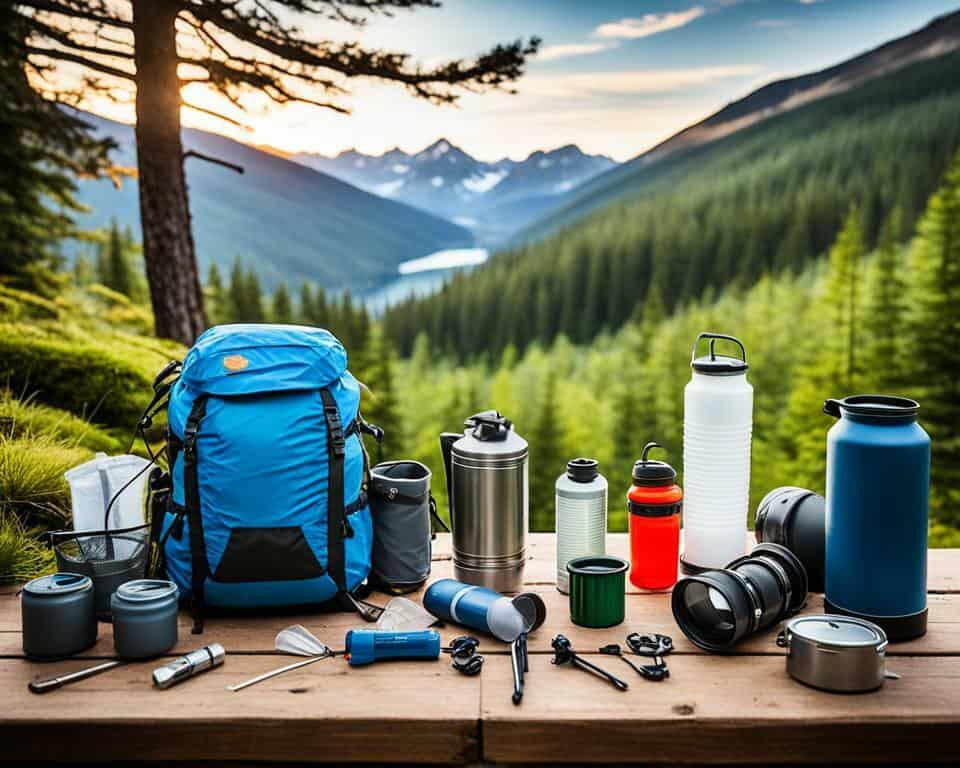
Multi-Tool Mastery: The Versatility of a Good Multi-Tool
Multi-tools have become synonymous with camping multi-tool necessity and are a fundamental piece of any outdoor toolkit. With an effective blend of functionality and portability, these compact devices pack a range of tools perfect for handling a myriad of tasks in the wilderness. From setting up camp to making quick repairs, the right multi-tool adds a layer of convenience that can greatly enhance your outdoor experience.
Choosing a multi-tool is a delicate balance between the variety of functions it offers and its overall durability. Considering a selection that includes essential features such as knives for slicing, pliers for gripping, saws for cutting through wood or cordage, and screwdrivers for gear repair is a smart start. But how do you pinpoint the one that matches your specific camping needs?
- Assess the commonly faced situations on your trips to determine which tools you’ll likely use the most.
- Look for a well-constructed multi-tool made from high-quality materials like stainless steel to ensure longevity and reliability.
- Check the ergonomics. A good multi-tool should feel comfortable in your hand and be easy to use.
- Read reviews and research brands that are known for making versatile camping equipment to make an informed decision.
Remember, your multi-tool is an investment in your outdoor safety and convenience. It’s worth taking the time to choose one that you can rely on for years to come.
Pack Smart: Space-Saving Tips and Organizational Tricks
Efficient packing is not only about what you pack, but how you pack it. The goal is to maximize camp storage without compromising on necessities. Camping organization begins with the strategic compartmentalization of your gear, which streamlines the packing and unpacking process, and ensures quick access to your essentials. Discover how foldable gear, packing cubes, and clever packing tactics can elevate your camping preparation to an art form.
Compartmentalization isn’t just a fancy word; it’s a functional approach to camping organization. By segregating your items according to type and need, you can prevent the all-too-common rummaging through an abyss of gear to find that one elusive item. Use packing cubes or separate bags for different categories, such as clothes, cooking utensils, and electronics. This method not only keeps your belongings orderly but also condenses them to free up valuable space.
In addition to compartmentalization, consider the wonders of foldable gear. Today’s outdoor market offers everything from collapsible cooking pots to fold-down chairs, all designed to make your load lighter and your pack more streamlined. These innovative designs have transformed the way we perceive efficient packing, ensuring that we don’t have to sacrifice comfort for compactness.
- Employ multi-use items that serve more than one purpose, thus reducing the number of individual items needed.
- Roll clothing instead of folding to fit more into your pack and reduce wrinkles.
- Opt for lightweight, compressible sleeping bags and pads that occupy less space and are easier to carry.
- Fill every nook and cranny of your backpack or car trunk, even using the insides of pots for small items.
By adopting these space-saving tips and organizational tricks, maximizing camp storage becomes less of a challenge and more of a strategy to enhance your overall camping experience. Prepare to bid farewell to cluttered campsite woes and embrace a more efficient, enjoyable outdoor adventure.
Conclusion
As we round off this comprehensive guide on essential camping trip gear, it’s our hope that you’ve found insightful suggestions to refine your camping trip preparation. Each piece of equipment we’ve discussed plays a pivotal role in ensuring that your adventure is as enjoyable and safe as possible. From securing the right shelter to choosing appropriate lighting, our gear review has covered the indispensable items that belong in every camper’s backpack.
Summary of Essential Camping Gear
In this article, we’ve traversed the landscape of necessary camping equipment, addressing everything from the best hiking boots to the most efficient water purification systems. Remember, the key to a satisfying outdoor experience lies in the quality and reliability of your gear. Whether braving the elements or cooking under the stars, your gear is your companion that must never let you down. Make sure to revisit each section, familiarize yourself with the features that suit your needs, and invest in gear that will endure the demanding nature of the wild.
Final Checklist Before Your Trip
Before you embark on your next adventure, take a moment to go through the final camping checklist. Double-check your gear, verify that you haven’t missed any critical items, and ensure everything is in working order. Cross-reference with the detailed notes provided and adjust for the specific demands of your camping destination. Proper preparation is the first step towards a memorable and successful journey into nature. As the saying goes, “It’s better to have it and not need it, than to need it and not have it.” Happy trails, and may your camping adventures be remarkable!
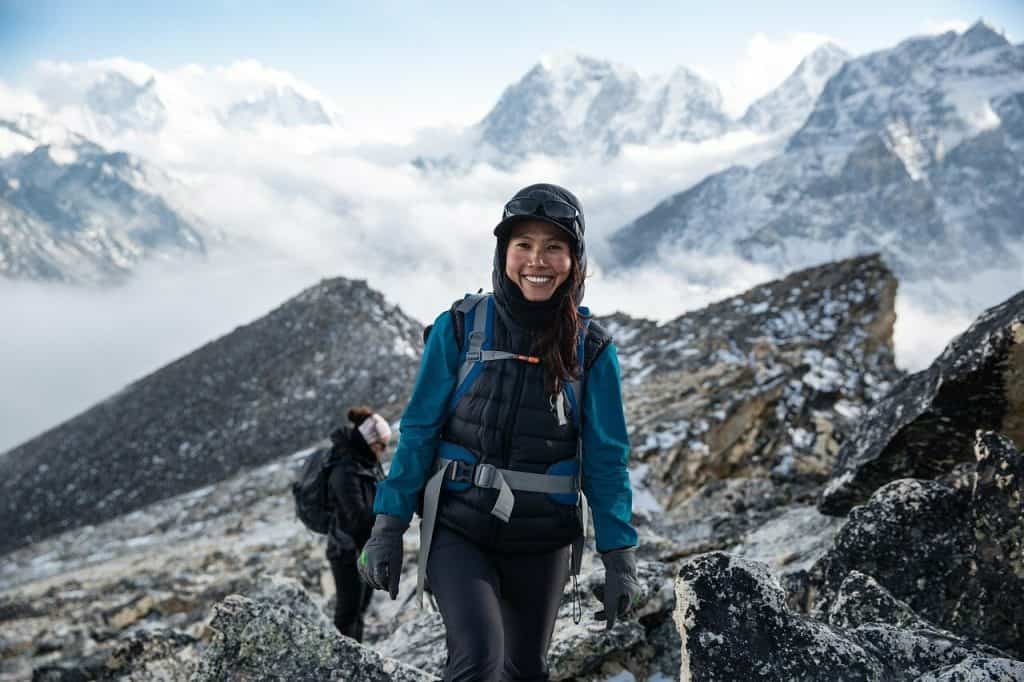
FAQ
What should I include in my camping gear checklist?
Your camping gear checklist should include a tent, sleeping bag, portable stove, food storage containers, water purification system, first aid kit, appropriate clothing, navigation tools like a map and compass, and a multi-tool. Tailor your checklist according to the environment and trip duration.
How do I choose the best tent for my camping trip?
Select a tent based on the space you need, expected weather conditions, and the environment you’ll be camping in. Look for features like waterproofing, ease of setup, and durability. A tarp can serve as additional shelter or ground cover.
What are the essentials for cooking while camping?
For cooking, bring a portable camping stove, fuel, lightweight and durable utensils, and food storage containers to protect your provisions from wildlife. Plan your meals in advance and consider easy-to-prepare options.
How important is a water purification system for camping?
A water purification system is crucial for ensuring a safe drinking water supply. Options include filters, chemical tablets, or UV light purifiers. Also, consider hydration systems like water bottles or bladders for easy access.
What is the best way to select hiking boots for my trip?
Choose hiking boots based on the terrain you’ll be traversing. Look for boots with good grip, ankle support, and waterproofing. Always try them on for fit and comfort, and break them in before your trip to avoid blisters.
What type of clothing should I pack for different weather conditions?
Pack weather-resistant clothing appropriate for the forecasted conditions. Layering is key, with moisture-wicking base layers, insulating mid-layers, and a waterproof outer layer. Don’t forget a hat and gloves for colder environments.
What should be in my camping first aid kit?
Your camping first aid kit should include bandages, antiseptic wipes, gauze, adhesive tape, blister treatments, pain relievers, allergy medications, tweezers, and any personal medications. Also consider adding a thermal blanket and a whistle for emergencies.
Why are reliable navigation tools important for wilderness trips?
Reliable navigation tools like maps, compasses, or GPS devices ensure you can find your way in remote areas and keep track of your route. They are essential for safety and can prevent you from getting lost.
How do I keep my camping gear organized?
Keep your gear organized by using packing cubes, compartmentalization, and labeling. Choose multi-use items and gear that can nest or fold to save on space. Plan your layout and pack strategically to maintain a tidy and functional campsite.
What lighting options are available for nighttime camping?
For night-time illumination, you can use headlamps for hands-free operation, lanterns to light up the campsite, or flashlights for directed light. Consider features like LED technology, rechargeable batteries, and brightness settings to meet your needs.











































